Un sito web veloce è essenziale per la felicità dei visitatori e per il posizionamento in alto nei motori di ricerca. Infatti, i motori di ricerca come Google considerano la velocità del sito un fattore importante per il posizionamento.
WP Super Cache è un popolare plugin che crea file HTML statici delle vostre pagine web. Ciò significa che il server non deve lavorare tanto, rendendo il sito più veloce per i visitatori.
Utilizziamo plugin per le prestazioni come Cloudflare e WP Rocket per migliorare la velocità di WPBeginner. WP Super Cache è un’alternativa gratuita che può migliorare significativamente le prestazioni, incrementare la SEO e migliorare l’esperienza utente dei visitatori del sito web.
In questo articolo vi guideremo nell’installazione e nell’impostazione di WP Super Cache sul vostro sito WordPress. Spiegheremo ogni passaggio in modo chiaro, così anche se non siete esperti di tecnologia, potrete seguirci. Alla fine, avrete un sito web più veloce che i visitatori e i motori di ricerca apprezzeranno.
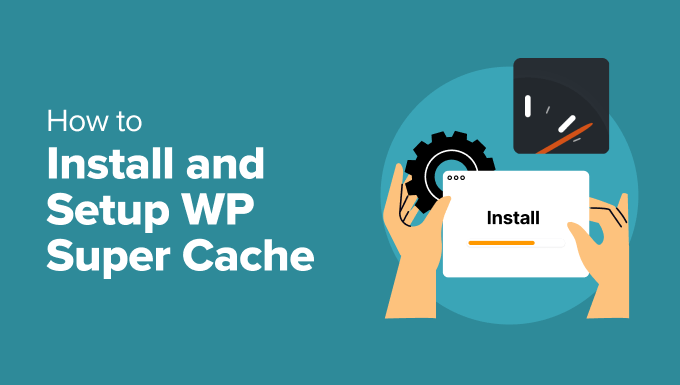
Cos’è WP Super Cache e perché si dovrebbe usare?
WP Super Cache è uno dei più popolari e migliori plugin per la cache di WordPress. È uno strumento gratuito e ha oltre un milione di installazioni attive.
WP Super Cache crea una copia in cache di ogni pagina del sito sotto forma di file HTML statico. In questo modo, ogni volta che qualcuno visita il vostro sito, gli viene servita rapidamente la versione copiata, invece di generare l’intero sito web da zero.
Di conseguenza, la velocità e le prestazioni del sito WordPress migliorano notevolmente. Il plugin per la cache salta molti passaggi dietro le quinte per garantire che i visitatori non debbano aspettare l’apertura della pagina.
Questo migliorerà l’esperienza dei visitatori del sito web. Un sito che si carica rapidamente incoraggia le persone a visitarlo più spesso, con conseguente aumento dell’engagement e delle conversioni, dato che gli utenti trascorrono più tempo sulle vostre pagine.
Inoltre, con un sito web che si carica velocemente, è possibile ottenere un aumento della SEO di WordPress e del posizionamento sui motori di ricerca. Questo perché Google dà un vantaggio significativo ai siti web più veloci, in quanto utilizza la velocità del sito web come fattore di ranking.
Ora, siete pronti ad impostare WP Super Cache sul vostro sito web? Diamoci da fare!
Impostazione di WP Super Cache – in modo semplice
La prima cosa da fare è installare e attivare il plugin WP Super Cache sul vostro sito web. Per maggiori dettagli, potete seguire la nostra guida su come installare un plugin di WordPress.
Al momento dell’attivazione, WP Super Cache vi informerà che al momento la cache non è abilitata sul vostro sito web.
Per abilitare la cache, andare su Impostazioni ” WP Super Cache. Poi, nella scheda “Facile”, fate clic sull’opzione “Cache on”. Una volta fatto ciò, fate clic sul pulsante “Aggiorna stato”.
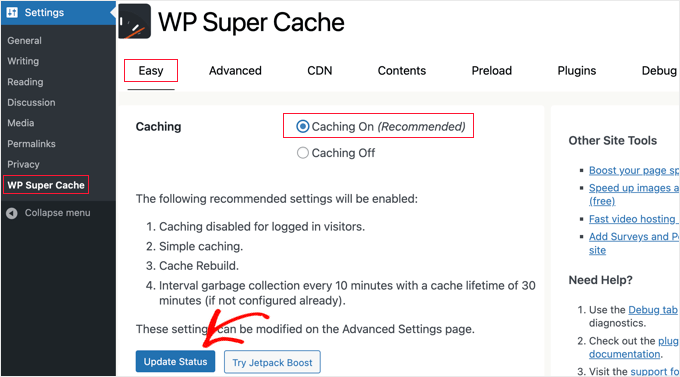
Dopo aver onorato la cache, è necessario scendere fino alla sezione “Cache Tester”.
A questo punto, fate clic sul pulsante “Test Cache” per verificare se funziona.
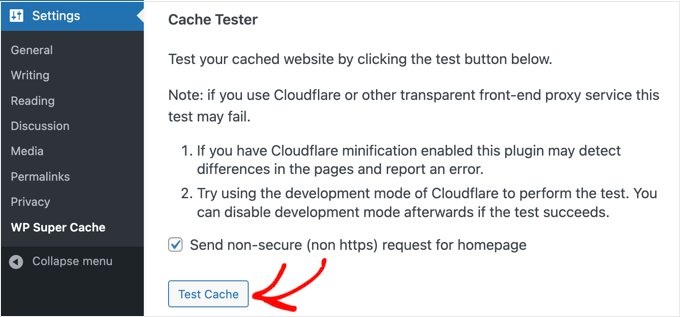
WP Super Cache recupera il sito WordPress due volte e confronta i timestamp delle due pagine. Se entrambi i timestamp corrispondono, significa che la cache è in corso di elaborazione sul sito.
Configurazione avanzata di WP Super Cache
WP Super Cache è un potente plugin per WordPress dotato di numerose opzioni avanzate. Queste opzioni possono migliorare ulteriormente le prestazioni del sito e dare all’utente un maggiore controllo sul modo in cui il plugin esegue la cache del sito.
Abilita la cache
Per impostare WP Super Cache con opzioni avanzate, andare alla scheda “Avanzate” nelle impostazioni del plugin WP Super Cache. Quindi, fare clic sul checkbox “Abilita cache”.
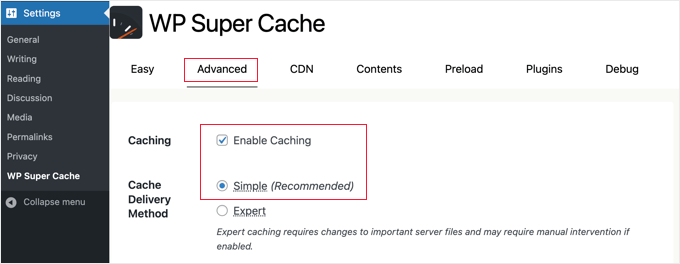
Sotto la cache, sono presenti opzioni per il “Metodo di consegna della cache”. Si consiglia di utilizzare l’opzione “Semplice” se si è alle prime armi e non si ha familiarità con la modifica dei file del server.
Dopo aver scelto l’opzione di caching, fare clic sul pulsante “Aggiorna stato”.
Abilitazione della compressione in WP Super Cache
La compressione permette a WP Super Cache di servire i file nella cache come file compressi, migliorando così il tempo di caricamento. Questi file sono più piccoli e possono essere scaricati dai browser più rapidamente.
Per abilitare la compressione, scorrere giù fino alla sezione “Varie” nella scheda delle impostazioni “Avanzate” e selezionare la casella “Comprimi le pagine in modo che vengano servite più rapidamente ai visitatori”.

Ancora una volta, cliccare sul pulsante “Aggiorna stato” per salvare le modifiche.
Abilitazione della cache dinamica
Se si desidera mantenere alcune parti di una pagina web dinamiche durante la cache, WP Super Cache offre un’opzione in tal senso.
L’abilitazione della cache dinamica è utile in alcune situazioni, soprattutto se le pagine contengono contenuti che cambiano frequentemente. Ad esempio, è possibile velocizzare le pagine che contengono annunci pubblicitari consentendo la cache dinamica.
Per abilitare questa opzione, si può andare nella sezione “Avanzate” e fare clic sul checkbox “Abilita la cache dinamica”.

Assicuratevi di salvare le modifiche quando avete finito.
Impostazione del tempo di scadenza e della garbage collection
WP Super Cache consente anche di impostare la scadenza e la frequenza di eliminazione delle pagine in cache dal server.
Per iniziare, è sufficiente scendere fino alla sezione “Tempo di scadenza e Garbage Collection” nella scheda “Avanzate” per configurarla.
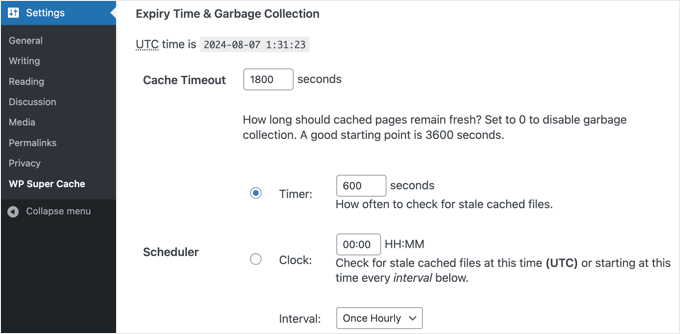
Il “Timeout della cache” indica al plugin di rimuovere la pagina memorizzata nella cache ed eseguire una nuova cache. Il plugin lo imposta a 1800 secondi in modo predefinito, il che è ottimo per un sito web ad alto traffico.
Tuttavia, se il sito web è nuovo e non riceve molto traffico, 3600 secondi sono un buon punto di partenza.
Oltre a questo, è possibile programmare un orario in cui il plugin controlla la presenza di file obsoleti nella cache e li rimuove.
Una volta terminate le selezioni, è necessario cliccare sul pulsante “Modifica scadenza” per salvare le modifiche.
Specificare le pagine che non si desidera vengano memorizzate nella cache
Per impostazione predefinita, il plugin memorizza nella cache tutte le pagine del sito. Questo può aumentare le dimensioni dei file della cache e consumare più risorse. Tuttavia, WP Super Cache consente di scegliere le pagine che non si desidera vengano memorizzate nella cache.
Per utilizzare questa caratteristica, è possibile scorrere verso il basso fino alla sezione “Stringhe URL rifiutate” nella scheda “Avanzate”. Nel boxed, inserire la stringa URL delle pagine che non si vuole che il plugin metta in cache.
Ad esempio, se avete un negozio di e-commerce, potete escludere le pagine che i visitatori non visitano spesso e salvare le risorse del server. Ad esempio, la pagina di pagamento, la pagina dell’account e la pagina di ringraziamento.
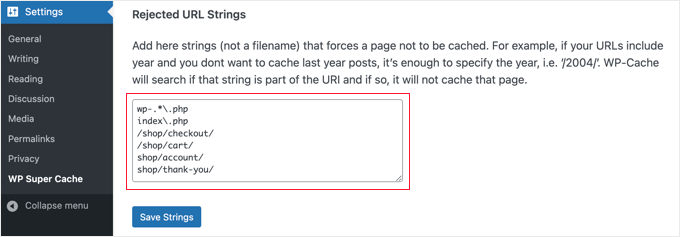
Al termine, non dimenticate di fare clic sul pulsante “Salva stringhe”.
Impostazione di WP Super Cache per il funzionamento del CDN
Se si utilizza anche un servizio di Content Delivery Network (CDN) per velocizzare il sito web, è possibile configurare WP Super Cache in modo che funzioni con esso. Altrimenti, potete tranquillamente saltare questa sezione.
Un CDN è un network o una rete di server distribuiti in diverse località geografiche, che aiuta a distribuire rapidamente i contenuti ai visitatori. Per maggiori dettagli, date un’occhiata alla nostra infografica sul perché avete bisogno di un CDN.
Suggerimento: consigliamo di utilizzare Cloudflare perché è un provider CDN gratuito e facile da impostare. Consultate il nostro tutorial su come impostare il CDN gratuito di Cloudflare sul vostro sito WordPress.
Per impostare WP Super Cache in modo che funzioni con il vostro CDN, fate clic sulla scheda CDN nelle impostazioni. Quindi, selezionate la casella accanto all’opzione “Abilita il supporto CDN”.
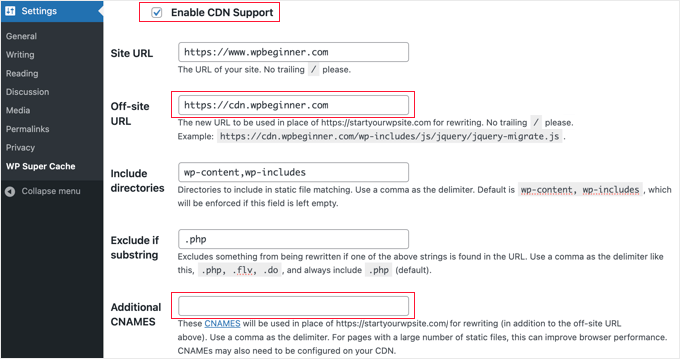
Successivamente, è necessario inserire il proprio “URL off-site”. Si tratta della “pull zone” del CDN, ovvero l’URL in cui i file sono memorizzati sul CDN.
L’impostazione dipende dal vostro servizio CDN, ma ecco alcuni suggerimenti:
- Se si utilizza Cloudflare, lasciare questo campo vuoto. WP Super Cache rileverà automaticamente e lavorerà con Cloudflare.
- Se si utilizza un servizio CDN diverso, si inserisce qualcosa come: https:
//cdn.wpbeginner.com.Assicuratevi di sostituire “wpBeginner.com” con il dominio del vostro sito web. - In caso di dubbio, è possibile accedere al servizio CDN e verificare l’impostazione della dashboard dell’account per “dominio”, “dominio CDN” o “URL CDN”.
Se si sa che il proprio CDN ha più URL, è possibile inserirli nel campo “Additional CNAMES”, come ad esempio: http: //cdn1.wpbeginner.com, http://cdn2.wpbeginner.com, http://cdn3.wpbeginner.com. Altrimenti, si dovrebbe lasciare questo campo vuoto.
Le altre impostazioni possono essere lasciate come predefinite. Infine, selezionate la casella “Salta gli URL https per evitare errori di “contenuto misto”” e fate clic sul pulsante “Salva modifiche”.
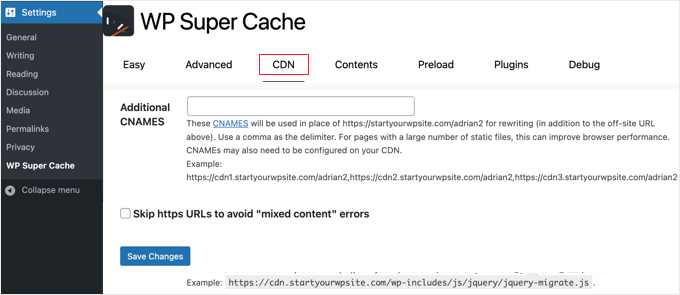
Ora il sito web è pronto per servire contenuti statici da un CDN.
Servire un sito statico con WP Super Cache
La modalità di precarica di WP Super Cache consente di creare file statici in super cache per tutti gli articoli e le pagine e di servire un sito web statico. In questo modo, i contenuti si caricheranno rapidamente ogni volta che qualcuno visiterà il vostro sito.
Un file statico in super cache aiuta a conservare le risorse del server, a servire un vecchio sito che non viene più aggiornato e a migliorare la velocità del sito servendo solo contenuti statici.
Per iniziare, si deve andare alla scheda “Precaricamento” del plugin WP Super Cache. Quindi, è possibile impostare l’ora in cui aggiornare i file della cache precaricati.
Di default, il plugin lo imposta a 600 minuti, ma è possibile diminuire il tempo se si pubblicano più articoli al giorno.
Ricordate che il precaricamento dell’intero sito WordPress richiede tempo e consuma molte risorse del server. Si può lasciare a 0 se non si vuole che i file statici scadano mai, a meno che non si aggiorni manualmente la cache.
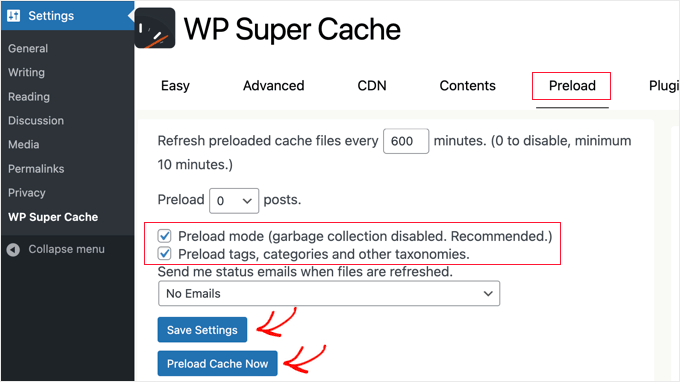
Successivamente, assicurarsi di selezionare le verifiche per “Modalità di precaricamento (garbage collection disabilitata. Consigliata)”. È anche possibile abilitare il precaricamento per diversi tag, categorie e altre tassonomie del sito web.
Il plugin offre anche un’opzione per ricevere avvisi via email ogni volta che i file vengono ricaricati. Di default, viene utilizzata l’impostazione “No email”, ma è possibile modificarla scegliendo un’opzione dal menu a discesa.
Al termine, salvare le impostazioni e fare clic sul pulsante “Precarica la cache ora”.
Guide di esperti sulla cache di WordPress
Speriamo che questa guida vi abbia aiutato a impostare WP Super Cache sul vostro blog WordPress. Potreste voler vedere altri articoli relativi alla cache di WordPress:
- Come correggere facilmente l’attenzione sulla cache del browser in WordPress
- Come cancellare la cache in WordPress (passo dopo passo)
- I migliori plugin per la cache di WordPress per velocizzare il vostro sito web
- LiteSpeed Cache vs. WP Rocket: qual è il migliore?
- Come installare e configurare correttamente WP Rocket in WordPress
- Come installare e configurare W3 Total Cache per i principianti
- La guida definitiva per aumentare la velocità e le prestazioni di WordPress
- Come velocizzare le prestazioni di WooCommerce
Se questo articolo vi è piaciuto, iscrivetevi al nostro canale YouTube per le esercitazioni video su WordPress. Potete trovarci anche su Twitter e Facebook.





Anze
Hey; I have a question – so preload mode enabled does not deletes old cached files – but does that means then when preloaded files are refreshed, the old ones are deleted and replaced, or does it just adding files, which would mean space on server would eventually run out?
WPBeginner Support
When the page is preloaded a new time, the old preloaded version would be deleted and replaced.
Admin
James Omeke
Thanks so much . This was very helpful.
I got my website up and running now
WPBeginner Support
You’re welcome, glad our guide was helpful!
Admin
Mike Royden
Plug in installed, but can’t get past this;
Permalink Structure Error
A custom url or permalink structure is required for this plugin to work correctly. Please go to the Permalinks Options Page to configure your permalinks.
I have gone to the Permalinks Options Page to configure your permalinks, but can’t see where I’m going wrong. Going round in circles, please help. Thanks
WPBeginner Support
You would want to ensure your permalinks are not set to plain for that error. We recommend using the Post name structure.
Admin
Mike Royden
Sorted! Many thanks for your advice and taking the time to reply. Cheers.
Katherine
I’m trying to set up this plug in to get the best results, and I’m not tech-savvy at all. Your Wp advanced cache set up section is not the same as the current plugin advanced options.
WPBeginner Support
Thank you for letting us know, we will be sure to take a look into this and update our article when able.
Admin
Simon
I was able to speed up my homepage significantly but unfortunately it only worked for the homepage. The subpages like i.e. ‘Services’ are still really slow.
What could be the problem?
WPBeginner Support
You would want to run a speed test for that using our guide below to figure that out:
https://www.wpbeginner.com/beginners-guide/how-to-properly-run-a-website-speed-test-best-tools/
Admin
Rainey
Unable to activate the plugin. I get a warning message that a .php file already exists and I should manually delete it before using the plugin. Since I am not a techie I do not know where to go to delete the file. If you could put language in your update to the tutorial to guide us would be really helpful.
WPBeginner Support
For that error, you may want to follow our guide below:
https://www.wpbeginner.com/wp-tutorials/how-to-fix-destination-folder-already-exists-error-in-wordpress/
Admin
Paul
This post is dated. When will this post be updated? Would like to know the current status of WP Super Cache?
WPBeginner Support
Thank you for letting us know, we do not have a specific date that content will be updated but we will take a look into updating this article
Admin
Nic
Is there a way to export settings once you get done?
WPBeginner Support
At the moment WP Super Cache does not have a built-in option to export settings.
Admin
ShoaiB
Thank you for this Awesome Guide.
I’m using WP Super Cache (Version 1.7.0 ). In the above tutorial, many features are not included. plz, Update Post.
WPBeginner Support
Thank you for your request, we will look into updating the post
Admin
Christopher
not as easy as described…
A custom url or permalink structure is required for this plugin to work correctly. Please go to the Permalinks Options Page to configure your permalinks.
WPBeginner Support
Thank you for reminding us of that, we’ll be sure to look into updating the article for clarification.
Admin
Ana
Hello Support!
Thank you for all your work, I’m a complete newbie and without you, I don’t know how I’d manage.
I’m confused as regards what off-site URLs and CNames are, so I’m unable to fill in that in the form. Do I have to refer to somewhere on my page to find out or do I just create it my indicating something?
Just in case it affects somehow I’d like to inform that I run a multisite.
Thank you so much & hope you can help me,
Ana
WPBeginner Support
Hi Ana,
The off site URL is the URL of your CDN location and CNames are different pullzones you have created on your CDN server. If you are not using a CDN, then you don’t need to make any changes to these settings.
Admin
krishna
can i use this plugin for testing in localhost ??
i installed this plugin in localhost and in “Cache Contents” nothing cached
displaying this …
WP-Cache (0KB)
0 Cached Pages
0 Expired Pages
WP-Super-Cache (0KB)
0 Cached Pages
0 Expired Pages
is it because i can’t use cache plugin in localhost or some other issue ?
Hardik
There is nothing called MOD_REWRITE. Everything from that step seems completely different. Please update the tutorial.
Mike
No matter what settings I use Pingdom still gives me an F and says “The following cacheable resources have a short freshness lifetime. Specify an expiration at least one week in the future for the following resources:” and I see and “expiration not specified” message in the details. Am I missing a setting?
Akshay
Hi Team ,
Thanks for the amazing article .
I have installed WP Super Cache with cloudflare (newbie blogger).
Can you please help me, how can I integrate cloudflare with WP super cache .
I did not found any articles or vidoes for the same .
I thought of installing WP Total , but it has not releasedthe update for recent wordpress version 4.8.1
Thank You
Sumaiya
Hi, I wanted to speed up my site. I used this guide and customized the settings as you shown. But before installing this plugin I tested my site speed it was 4.20 sec. But after installing I check it was 6.78 sec. Why is it like this? please guide me well.
WPBeginner Support
Hi Sumaiya,
Please test it again. If the result persists, then deactivate the plugin.
Admin
Rajeev jaiswal
hello sir, I’m trying to integrate js and CSS code elements in twenty-seventeen WordPress theme. I use enqueue methods but it does not work, so suggest me to all about.
Sara
I just downloaded WP Super Cache and the “Advanced” Page doesn’t have the same setup (or some of the same options!) as your screenshot and instructions. Are those dates, or did I somehow end up with an older version of the plugin?
Carrie
Same here, my settings are different.
Abner
Hi guys – Thanks for sharing this. I am using wp super cache and my wordpress is 4.0.1. At first, i don’t have any problem. Until recently, having a problem. My post did not appear on my website. I tried to put the caching off and my post appear. After that, I put the caching on again. My workaround was after posting article to my website, I will put my caching off to appear the post in my website, then after a few minutes, I will put the caching to on.
Few weeks doing that, and now, when I put the caching on, my post will disappear again to my website. As of now, my caching is still off.
Thanks and hope you can help me.
WPBeginner Support
Hi Abner,
Seems like WP Super Cache is not clearing the cache when you publish new content. Please see our article on how to clear cache in WordPress.
Admin
Mark Layton
Hello Support,
Thank You for your help with this issue while trying to install WP Super Cache.
Here is a copy of issue :
Warning! Could not update /var/www/website/wp-config.php! WPCACHEHOME must be set in config file.
Warning! /var/www/website/wp-content/advanced-cache.php does not exist or cannot be updated.
1. If it already exists, please delete the file first.
2. Make /var/www/website/wp-content writable using the chmod command through your ftp or server software. (chmod 777 /var/www/website/wp-content) and refresh this page. This is only a temporary measure and you’ll have to make it read only afterwards again. (Change 777 to 755 in the previous command)
3. Refresh this page to update /var/www/website/wp-content/advanced-cache.php
If that doesn’t work, make sure the file /var/www/website/wp-content/advanced-cache.php doesn’t exist:
1. Open /var/www/website/wp-content/plugins/wp-super-cache/advanced-cache.php$wp_cache_file in a text editor.
2. Change the text CACHEHOME to /var/www/website/wp-content/plugins/wp-super-cache/
3. Save the file and copy it to /var/www/website/wp-content/advanced-cache.php and refresh this page.
Cannot continue… fix previous problems and retry.
Already use your Envira Gallery and WP Forms and those are fantastic.
Should I just use W3 Total Cache instead?
Thank You so much for your help.
Mark Layton
WPBeginner Support
Hey Mark,
You can try following the instructions shown in WP Super Cache. If you find them too complicated, then you can try W3 Total Cache. Good luck
Admin
sheikave Jhurreea
Initially my website was loading for under 8 seconds which is pretty bad. But using your tutorial I was able get 90/100 for desktop performance.
But the mobile platform it remained 74/100. Could you suggest some resources where I could look up too or what is your suggestion.
WPBeginner Support
Hey Sheikave,
Congrats! That’s impressive. You may also want to see our guide on how to fix render-blocking JavaScript and CSS in WordPress.
Admin